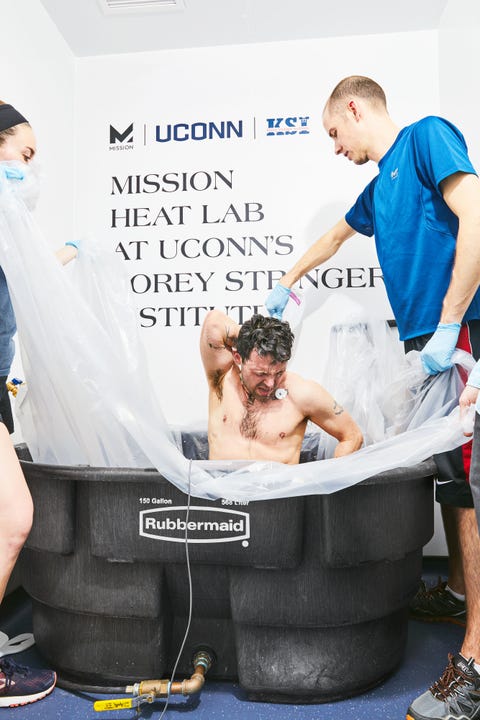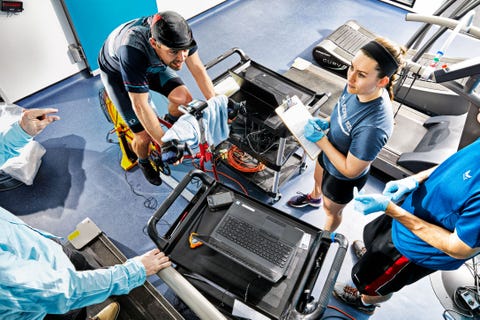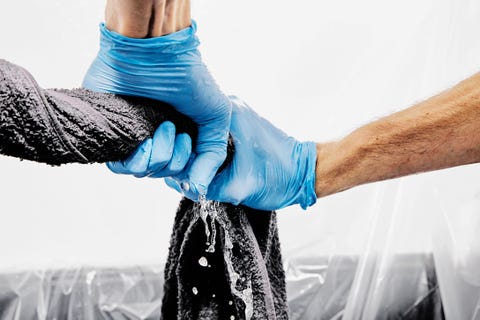“We call this the awkward shower,” says Robert Huggins, Ph.D. I’m on my knees in a tarp-lined tub while a Ph.D. student named Cody sends a waterfall of deionized water down from the plastic jug he holds over my head. Here at the University of Connecticut’s Korey Stringer Institute (KSI), they’re trying to collect every drop of sweat I just worked up on a bike ride. “Just scrub with your hands wherever the water hits,” says Huggins. “Sweat likes to hide in those little body hairs.”
The shower is only one part of today’s test. I’m here to find out how my body responds to heat, having heard that training in hot weather can make you a better athlete—if you don’t die of heatstroke first. The past five years have produced the highest average temperatures ever recorded, and with 2019 tracking to be hotter still, I’m hoping that my heat-lab visit will help me discover some extra power, since I’m a cyclist who’s comfortable toward the back of the pack. KSI says that if I can learn to handle the heat, I may be able to move up, maybe even lead.

Giacomo Fortunato
To see how I react to training in the heat, scientists track my temperature and heart data. They collect sweat from my body and clothes, measuring its volume and electrolytes to create a custom hydration plan to help me perform better. Under the water, I drag my fingers through my scalp, swimsuit model–like, and it’s every bit as awkward as Huggins warned. But then I hit the electrodes stuck to my chest, which brings me back to the fact that I’m a lab rat. I even have a tail of sorts: a thermometer poking out of my ass with a cable that attaches to a computer. It doesn’t hurt, exactly, but every time the tail moves, I feel like I really need a bathroom.
Moments before the awkward shower, I was pedaling a 55-pound flywheel hooked to a stationary bike while technicians monitored my heart and core body temperature inside the $700,000 Mission Heat Lab. The small room has the sterile veneer of a hotel gym but with giant fans and rolling carts of specialized testing equipment.
The climate inside the lab can reach 110 degrees with 90 percent humidity. Conditions like that are grueling to work out in, but they can make athletes stronger and faster—not just in the heat but at any temperature. “It’s like legal blood doping,” says Huggins, who still runs competitively himself. “If you train in high temperatures, you’ll have performance benefits in both the hot and cold.”

Douglas Casa, Ph.D., runs KSI and the heat lab. In his office, surrounded by memorabilia from organizations he’s worked with, including the NCAA and the NFL, he explains to me how it works.
Before heat speeds you up, it slows your workout down
During a standard gym workout, your skeletal muscles and heart both require extra blood. If the gym’s AC were to break on a hot day, “suddenly your skin needs a lot more blood too,” Casa says. “That’s how you cool yourself down—you send hot blood right to the skin’s surface so you can sweat the heat out.” All of a sudden, your body is trying to send blood to three places—skin, muscles, and heart—instead of just two. Something’s gotta give, and it ends up being your speed and stamina.
I’m reminded of my own embarrassing hot-weather moment last year during a bike-packing trip. I’d spent months training in 60-degree weather in South America. When I returned, I went straight to Fort Collins, Colorado. I felt strong at the start, but as the heat passed 90 degrees, my legs grew heavy and my riding pals eventually left me behind.
The problem, as Casa explains it, was that I was air-conditioning fit but not heat fit, so my hypothalamus—the brain’s governor—began cutting back my available energy. “It’s called volitional exhaustion,” says Casa. “It’s so you don’t kill yourself.”
That’s where heat training becomes useful. In response to hot, humid workouts, along with other helpful physiological changes, your body increases your blood volume—the amount of fluid circulating in your vessels—which makes you more efficient at regulating temperature. And that’s why I’m at KSI today: to see what it feels like to work out close, but not too close, to the threshold of heatstroke, so I can get the benefits of training there.
Training in the heat can make you—unless it breaks you
I can’t tell if it’s the heat or the probe in my rectum, but I’m sweating even before I pedal. The quickest way to acclimate to the heat so you perform well here is to crank your temperature up to a level that’s just below dangerous. As my test progresses, Huggins’s students periodically tap a few computer keys to dial up the resistance. I watch my temperature tick upward on one of the wall-mounted TVs. The goal is to hold steady between 101 and 103 degrees, and I hit that range within ten minutes.
“When an athlete hits 104, we shut it down,” says Huggins. Cell damage generally occurs around 105.5 degrees. That’s enough to begin frying your guts like eggs, and the result is heatstroke.

In the run-up to something like the Ironman World Championship in Kona, athletes pay $200 for the heat-lab experience. By going two days on, one day off for seven to ten days, you can significantly increase your blood volume and decrease your heart rate and resting body temp. “That alone provides 80 to 90 percent of the heat-acclimation benefits,” says Casa.
After three weeks—if you were fit when you started—you’re ready for hot-weather competition at an elite level. Without maintenance, most of the acclimation benefits will last for about a week or two, but with a couple hot-weather training sessions per week, you can hold on to these benefits indefinitely.
But I’m not competing in Kona, and I don’t have $200 to spend on an hour in the gym. For me, this is about understanding what I can do on my own to avoid being dropped on a ride. Learning how hot to be is a big part of it, and I discover that I have to drink enough, too. The less you drink as you sweat, the more your hard-earned blood volume decreases. Which means less cooling and either a slowdown in pace or internal fried eggs. “For every 1 percent body-mass loss, your heart rate will be three beats faster and your core temperature will be half a degree higher,” says Huggins. To figure out how much you should be drinking, you can do a rough at-home test: Subtract your weight after a workout (add how many ounces you drank during it) from your weight before that workout. If your weight drops by 2 percent, you’re not drinking enough. If it increases by more than 2 percent, you’re drinking too much, which can be more dangerous than dehydration.
Train for the heat without the lab
To prepare me for my next adventure in the heat, Huggins offers an at-home acclimation method: Set up two space heaters and a humidifier and crank them up while you’re working out. Huggins also wants you to use a rectal thermometer—for accuracy and safety—to keep your temperature between 101 and 103. Pushing your body temp over 104 can put you in danger.
Of course, there’s always the casual option: Spend more time outside and less time in a climate-controlled gym. And when the forecast shows heat and humidity, make that a training day.
Source: Read Full Article
